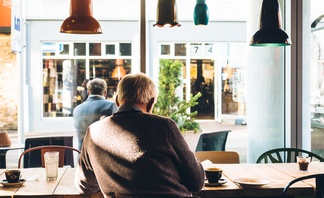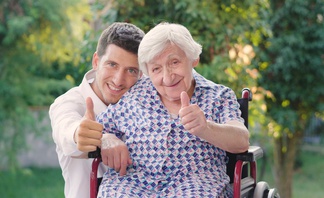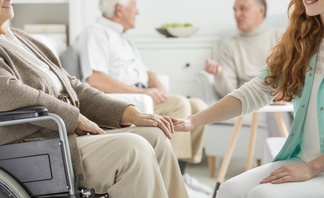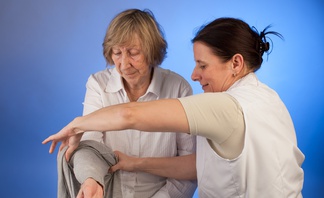Life is movement.
As long as we feel every fiber of our being and control our body - we stay healthy and full of energy inside. It doesn’t matter how old we are; age shouldn’t become an obstacle or excuse. A proper set of mind and desire to feel life through the motion - this is what makes life integral.
In this post, you’ll learn how to stay active as a senior. We’ll cover different types of exercises for the elderly that will make your life balanced, improve your health, clear your mind, and make you feel safe and sound. Prepare for the positive changes.
The importance of exercise for the elderly
When it comes to aging, there are two types of it: “eugeric” and “pathogeric”.
Eugeric aging is a natural way of getting older. It usually includes the processes we can’t avoid: such as hair graying or occurrence of wrinkles. When pathogeric aging is pathological process accompanied by diseases e.g. reduced cardiovascular function, increased blood pressure, increased body fat level, etc. This is the type of aging caused by physical inactivity and an unhealthy lifestyle. But the good news is that you can avoid it.
Physical activity - this is our remedy. Recent studies have found that physical activity may change the way we age.
An experiment by a Journal of Applied Physiology showed that regular activity might keep your body 30 years younger. Researchers have recruited three groups of people: seniors in their 70s who maintained sport as a hobby during their whole life, people of the same age who lived a sedentary life, and young group of people in their 20s. The study mostly focused on the cardiovascular system and muscles which tend to decline with age.
The results were inspiring.
The muscles of older exercisers resembled the muscles of young people. Also, their cardiovascular capacities were 40% higher than in their inactive peers. These findings prove that things we consider to be normal physical deterioration with aging are possible to avoid.
Benefits of exercise for seniors
Here are the main advantages of regular physical activity for the elderly.
Increases metabolism across brain regions
Exercises have a positive effect on cognitive functions in elderly people. Studies prove that aerobic activity boosts brain structure, function, and condition, as well as diminish the impact of brain changes on cognition. Physical activity also delivers oxygen to the brain and protects brain cells from degeneration.
Helps maintain mobility in vulnerable older people
According to the study by National Institute of Aging, regular and moderate physical activity followed for an average of 3 years reduced the risk of major disability by 18% in the elderly vulnerable population.
“At the beginning of this trial, all the participants were at high risk for mobility disability,” said Evan Hadley, M.D., director of the NIA Division of Geriatrics and Clinical Gerontology. “At the start, they were able to walk about a quarter of a mile without a cane, walker, or help of another person. But they did have sedentary lifestyles and low scores on some standard physical tests that measure risk for disability.
Lowers risk of developing Alzheimer's disease and mild cognitive impairment
Physical activity increases the number of chemicals that protect your brain and counters reduction in brain connections that occur with age. It results in better memory, judging, and cognitive function in seniors.
The study published in the Journal of Alzheimer’s Disease proved that stronger muscles are associated with a slower rate of cognitive decline. It followed 970 participants during nearly 10 years and has found that those with stronger physical health had a 61% lower risk of developing Alzheimer's disease.
Increases balance and prevents falls
Regular exercising reduces the risk of a fall as it makes your muscles and bones stronger, gives you more energy for balance as well as the ability to control your body.
Lowers the risk of heart diseases
Regular sports activity lowers blood pressure, increases HDL cholesterol (that transports fat from the arteries) and reduces LDL cholesterol (that forms fatty deposits in the arteries). These all contribute to better heart functioning and circulation.
Cardiovascular Health Study that followed more than 4,200 U.S. adults during 10 years found that higher level of physical activity was associated with a lower risk for heart events even in adults over 75 years old.
Why elderly people don’t exercise enough
The benefits of physical activity seem to be endless. So why most of the elderly people don’t exercise and have a sedentary lifestyle? Here are the main barriers to exercising elderly people have and tips on how to overcome them.
Risk of fall and injury
Fear of injury or fall is one of the most common barriers the elderly have.
The best way to overcome it is a thorough preparation that will help seniors ensure safe physical activity.
-
Talk to your doctor before starting any type of physical activity. Make sure to be aware of any limitations, allowed training time, safe heart rate, training program, and equipment you need. Don’t be afraid to share your fears with the therapist.
-
Wear convenient footwear with heel support and non-skid soles that strongly fix your leg.
-
Stretch before any activity to warm up your muscles and set up your mind.
-
Start at a slow pace and increase physical activity gradually.
-
Listen to your body, this is your best doctor.
Low self-efficacy and motivation
A positive set of mind and belief in the power of sport make exercising even more effective and drives better results. Our body reflects our emotions, so if you exercise without excitement and motivation - your body will react to changes slower and results cannot be so satisfactory.
Here are some tips on how to motivate and encourage seniors to train:
-
Create small and achievable goals every day that will make seniors feel proud of themselves (e.g. do 10 sit-ups or 5 minutes of stretching every day).
-
Ask a therapist to prepare the physical activity program in a written form, mention the benefits of each exercise, and useful instructions - this is a great motivational tool that will help seniors remember what they do it for.
-
Encourage companionship - senior centers or exercise classes for seniors are places where elderly people will find support and motivation.
-
Keep physical activity diverse and don’t turn it into a routine
Physical discomfort
Sometimes even small physical discomfort can make seniors stop and think that physical activity is not for them.
Remember that if there’s any physical discomfort, it’s better to stop doing that kind of activity and consult with the doctor. It means that you should slightly change your training program or choose another activity suitable for you.
The most important thing here is to find the courage to continue and don’t give up. It’s never too late to improve your health. Just look at these examples of seniors who don’t let the age to knock them off the wagon, isn’t it motivational?
How often should the elderly exercise?
World Health Organization recommends 65+ adults perform the leisure-time physical activity as a part of their daily life (such as walking, dancing, gardening, swimming, household chores).
For those who want to improve cardiorespiratory and muscular fitness, it’s recommended to:
-
Do 150 min of moderate physical activity throughout the week
-
Do 75 min per week of vigorous aerobic exercise (such as brisk walking or biking)
-
Perform muscle-strengthening activities 2 days a week (8 to 10 strength-training exercises)
-
Perform activities that enhance balance and prevent falls 3 times a week (20-30 min per day)
Remember that these are the general guidelines that are not suitable for everyone. Consult with a doctor and ask to create an individual training program. Seniors should also listen to their body and increase or decrease physical activity accordingly.
Now let’s get straight to the best workout plans for seniors.
Balance exercises for seniors
Balance training reduces falls, makes your muscles stronger and maintains clearer thinking.
Balance exercises provided below are easy and gentle, so don’t worry if you do them at first. Do these exercises 2 times a week, start with one repetition and then try to gradually increase them.
Sideways walking
A. Stand with your feet together, knees slightly bent.
B. Step sideways in a slow and controlled manner, moving one foot to the side first.
C. Move the other to join it.
Avoid dropping your hips as you step. Perform 10 steps each way or step from one side of the room to the other.
Simple grapevine
A. Start by crossing your right foot over your left.
B. Bring your left foot to join it.
Attempt 5 cross-steps on each side. If necessary, put your fingers against a wall for stability. The smaller the step, the more you work on your balance.
Heel-to-toe walk
-
Put your right foot in front of your left foot so that the heel of your right foot touches the top of the toes of your left foot.
-
Move your left foot in front of your right, putting your weight on your heel.
-
Then, shift your weight to your toes.
Repeat the step with your left foot. Walk this way for 20 steps.
One-leg stand
-
Start by standing facing the wall, with arms outstretched and your fingertips touching the wall.
-
B. Lift your left leg, keep your hips level and keep a slight bend in the opposite leg. Gently place your foot back on the floor.
Hold the lift for 5 to 10 seconds and perform 3 on each side.
Wall push-ups
-
Stand an arm’s length in front of a wall that doesn’t have any paintings, decorations, windows or doors.
-
Lean forward slightly and put your palms flat on the wall at the height and width of your shoulders.
-
Keep your feet planted as you slowly bring your body towards the wall.
-
Gently push yourself back so that your arms are straight.
Do twenty of these.
Marching in place
Standing straight, lift your right knee as high as you can. Lower it, then lift the left leg. Lift and lower your legs 20 times.
You can use a chair if you need to hold.
Chair exercises for elderly adults
Chair exercises don’t require a lot of effort and don’t put pressure on your body. They are easy to perform and effective at the same time.
Seated hip marches
-
Sit tall on a sturdy chair, your feet flat on the floor, hip-distance apart.
-
Grasp the edges or armrests of the chair with both hands and engage your abdominal muscles to help keep your torso tall.
-
LIft your right leg with your knee bent as high as you comfortably can, as though doing a high-knee march.
-
Lower your right foot to the floor with control.
-
Repeat to the opposite side.
Perform at least 20 alternating marches.
Heel Slides
-
Sit tall in a sturdy chair, with knees bent and feet flat on the floor about hip-distance apart.
-
Extend the right leg and flex the right foot, so the heel remains in contact with the ground, but the toes are pointing up toward the ceiling.
-
Engage your glutes and hamstrings, using these muscle groups to drag your right heel back toward the chair while it remains in contact with the floor.
-
Reverse the movement and slide your heel away from you, extending your right knee.
-
Perform 10 to 12 repetitions on one side before switching legs.
Complete two to three sets per leg.
Modified leg lifts
-
Sit tall in a chair, your core engaged, your feet together and flat on the floor. Roll your shoulders back to maintain perfect posture.
-
Hold the chair's armrests or grip the chair's seat. Keeping your feet and knees together, lift both legs as high as you can (with knees bent) as you exhale.
-
Hold for five seconds, then lower your feet back to the floor.
Perform 10 to 12 repetitions and complete a total of three to five sets.
Strength exercises for seniors
Strong muscles help prevent falls, improve stability, and increase bone density. Here are some of the best.
Bicep curl
-
Take a weight that is appropriate for your current level of strength.
-
Sit with good posture in a chair (remember to engage your core by imagining your sternum moving back towards your spine, to stabilize your posture); one dumbbell in each hand, palms facing forward, shoulders relaxed, and elbows close to your body
-
Focusing on your bicep muscle, bend your arm at the elbows and lift the weights about ¾ of the way toward your shoulders. Avoid rotating your shoulders forward, and keep your elbows fixed at your side
-
Breathe out as you lift the weight, and breathe in as you lower them
-
Do 10 to 12 repetitions
Punches
Punching is a great way to warm up the upper body and get the blood pumping all over. Perform for 1 minute.
A) Stand with feet slightly wider than shoulder-distance apart and bend knees slightly. Tighten the core to keep your center still.
B) Punch out one arm at a time at a steady pace.
Knee thrusters
A) Start standing with feet wider than shoulder distance apart and turn both feet in one direction allowing the hips to follow like you’re in a shallow lunge. The front knee is a 90-degree angle and the back heel lifted. Arms are in a guard position in front of the chest.
B) Drive the back knee up to hip height towards the hands and hands in towards the thigh. Return the foot to the floor and repeat.
Shoulder overhead press
A) Start with feet hip distance apart. Bring elbows out to the side creating a goal post position with arms, dumbbells are at the side of the head, and abdominals are tight.
B) Press dumbbells slowly up until arms are straight. Slowly return to starting position with control. Repeat for the desired number of reps.
Glute bridge
A) Lie on back with bent knees hip distance apart and feet flat on mat stacked under the knees.
B) Engage the core and squeeze your glutes as you lift your hips to a bridge. Hold, squeezing tight, and return to the mat with control.
Bird dog
A) Kneel on the mat on all fours. Reach one arm long, draw in the abdominals, and extend the opposite leg long behind you.
B) Repeat on the other side.
Mid-back extension
A) Start lying face down on the mat. Lift abs away from the mat to engage them and slide the shoulders down the back. The head is lifted in a low hover. Your body is one long line.
B) Using your back muscles and core, lift the chest away from the mat into extension as you exhale. Think of lengthening from the crown of the head.
C) Inhale and return back down to the mat slowly getting longer through the spine as you return.
Flexibility exercises for elderly
Flexibility exercises lengthen and stretch your muscles and help you prevent injuries. Do flexibility exercises after the main workout to cool down your muscles and relax your body.
Shoulder and upper back stretch
-
Begin standing tall, arms by your sides. Now, reaching behind you with both hands, pull your shoulders back and clasp your fingers together.
-
If you feel a stretch already, hold it here. If you can go further, push your clasped hands away from your lower back and gently arc backward.
-
Return to standing tall, and repeat.
Triceps stretch
-
Sitting tall in a chair (or standing), lift your right arm up overhead, bending at your elbow.
-
Now, reach your opposite arm up to clasp your elbow, and pull gently in the opposite direction. You should feel a light stretch through the back of your arm.
-
Hold for 20 to 30 seconds, then switch arms.
Standing quadriceps stretch
-
Begin standing tall, holding onto the back of a chair or countertop with your free hand for balance.
-
Slowly bend your right knee and grasp your foot. At this point, you might already feel a stretch through the front of your thigh.
-
Hold this stretch for 30 seconds, then repeat on the other leg.
-
If you’re having trouble reaching your foot with your hand, try using a yoga strap or band, as mentioned above.
Heel raises
-
Sitting in a chair, keep your toes and the balls of your feet on the floor and lift your heels.
-
Repeat 20 times.
Knee lifts
-
Seated in a chair, with your arms resting but not pressing on the armrests, contract your right quadriceps muscles and lift your leg. Your knee and the back of your thigh should be 2 or 3 inches off the seat.
-
Pause for 3 seconds and slowly lower your leg.
-
Complete 8 to 12 repetitions and then repeat with the opposite leg.
Downward facing dog
Start on hands and knees, tuck your toes under, and lift your hips up and back until your body forms a triangle. Use your core strength and legs to bring the weight back as much as possible.
Conclusion
We want to end this article with the quote by Mark Twain: “Age is an issue of mind over matter. If you don’t mind, it doesn’t matter.”
Aging is a natural process everyone will face. However, we have the power to not let the aging knock us off-balance and physical activity is one of the best ways to do this.





